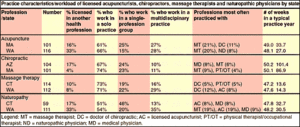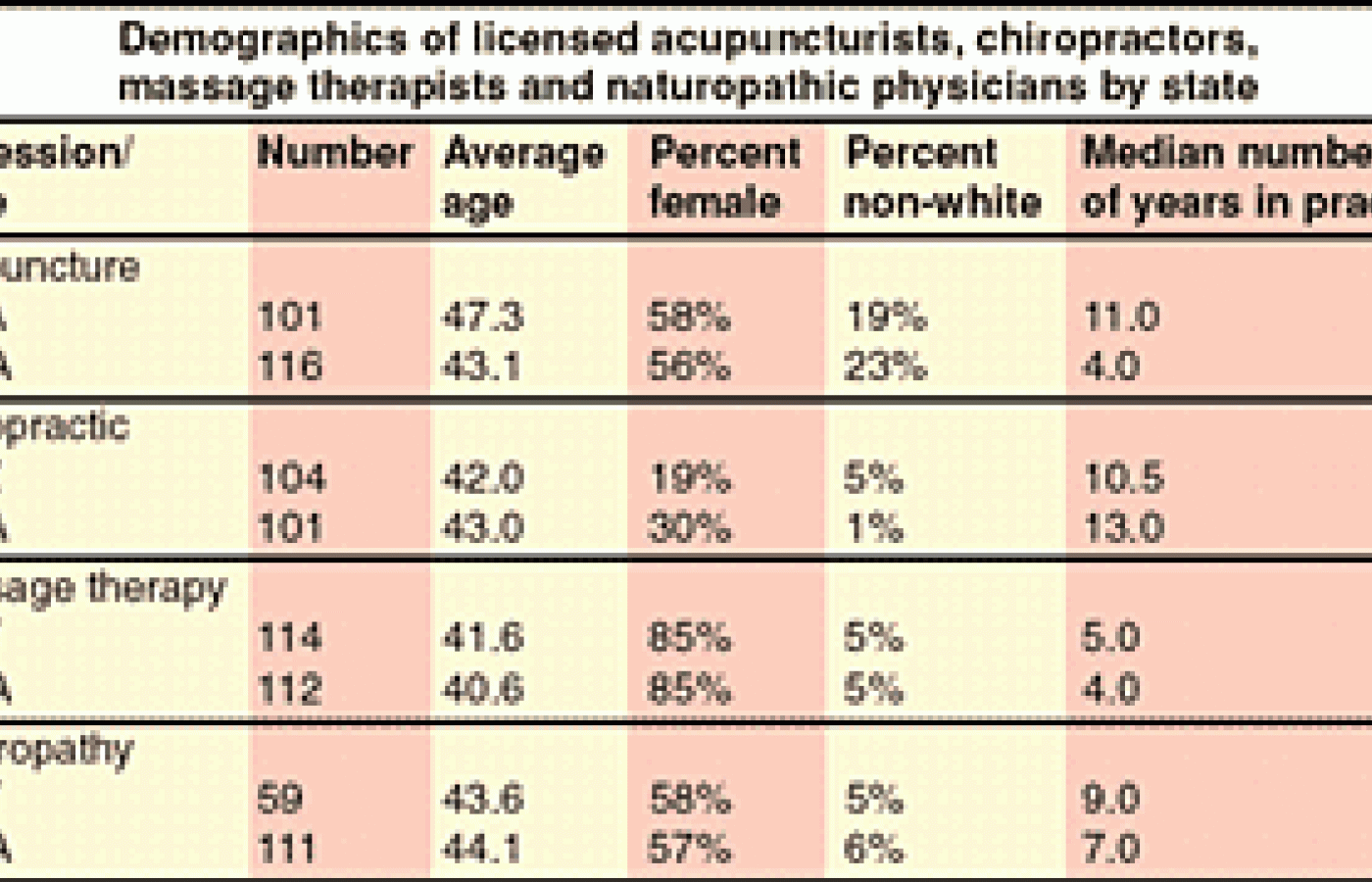People today want convenience, whether it be from their bank, credit card, favorite retail store, or restaurant. They demand it from the companies who hold their loyalty, including their health care providers (you). They don’t want to call and possibly be put on hold, and they want to use an app or schedule an appointment on your website. Here are three reasons your practice can gain by switching to online appointment scheduling.
Characteristics of Licensed Acupuncturists
The Journal of the American Board of Family Practice (JABFP) has published a new study documenting the practice characteristics of providers of complementary and alternative medicine (CAM) in the United States, including licensed acupuncturists. The study, which can be downloaded for free over the Internet, compares the practice patterns of acupuncturists with chiropractors, massage therapists and naturopathic physicians, and provides data that has been sorely lacking in the acupuncture profession.
In the study, the authors surveyed each of the four types of providers in two states they considered "nationally representative" of the profession being surveyed. States in the Northeast and West were chosen to "enable examination of geographic diversity." For acupuncture, the researchers selected Massachusetts and Washington; these states, along with Arizona and Connecticut, were used for surveys of the other professions. A total of 227 acupuncturists met the criteria for the study, and were interviewed by telephone. During the interviews, the acupuncturists answered questions on a variety of subjects, including demographics; training and practice characteristics; practice workload; professional trends; and contributions to the field of health care. Among the study's findings:
Demographics
- The average age of the acupuncturists interviewed was 47.3 in Massachusetts and 43.1 in Washington. Massachusetts acupuncturists had the highest average age of any group in the survey. These figures were in line with the other professions surveyed, which ranged from 40.6 (massage therapists in Washington) to 44.1 (naturopaths in Washington).
- A majority of acupuncturists in both Washington (56%) and Massachusetts (58%) were female. In comparison, 85% of massage therapists in Washington and Connecticut were female. Only 19% and 30% of chiropractors in Arizona and Massachusetts were female, respectively.
- Acupuncture had the highest percentage of nonwhite practitioners of any profession. Approximately 20% of all acupuncturists were Asian; Hispanics and African-Americans each made up less than two percent of the profession.

Training and Practice
- The average length of a training program for acupuncturists was three years, compared to four years for chiropractors and naturopaths, and 600-650 hours for massage therapists. About 30% of the acupuncturists surveyed in Washington and Massachusetts received some or all of their training outside the United States, mostly in China or England.
- The average number of years an acupuncturist had been in practice differed greatly between Massachusetts (11 years) and Washington (4 years). Although the researchers didn't speculate, the difference in length of practice may have had to do with the time acupuncture colleges founded in each state. The New England School of Acupuncture, the oldest school in the U.S., was founded in Massachusetts in 1975, several years before Bastyr University and the Northwest Institute of Acupuncture and Oriental Medicine opened in Washington.
- One-third of all acupuncturists in Washington and one-sixth of all acupuncturists in Massachusetts were licensed in another health profession, most commonly nursing, massage or naturopathy.
- More than 60% of acupuncturists in each state operated a solo practice. Substantial percentages of LAcs worked in multidisciplinary settings (27% in Massachusetts, 28% in Washington). Acupuncturists most often worked with massage therapists (21% in MA, 20% in WA) or chiropractors (11% in MA). Less than 10% of all alternative health care providers surveyed worked with medical doctors.
Practice Workload
- The typical acupuncturist worked just under 49 weeks per year, slightly more than massage therapists and approximately one week less than the average chiropractor.
- In a typical week, an acupuncturist had between 27.0 (Washington) and 33.7 (Massachusetts) patient visits peer week, and spent from 23.2-28.2 hours of direct patient contact. This translated into seeing approximately 1.2 patients per hour of direct patient care. In comparison, massage therapists in Connecticut saw as few as 13.6 patients in a typical week. Chiropractors in Arizona, meanwhile saw an average of 101.4 patients per week, but they also spent approximately one-third as much time with individual patients as acupuncturists.
Trends
- More whites and females are choosing acupuncture as a profession. The researchers compared statistics on alternative health care providers who completed basic professional basic training before 1990 with those who had completed training during the 1990s. According to this analysis, recent graduates of acupuncture programs were "significantly more likely to be female than earlier graduates." Recently trained acupuncturists were "significantly more likely" to be white than earlier graduates.
- Acupuncturists are also graduating at an older age than their predecessors. According to data compiled by the researchers, "the average age at completion of basic training was about six years older for recent acupuncturists." This could relate to the growing number of people who have embarked on acupuncture as a second career. It could also signify that many health care professionals, having already established themselves in one field, are interested in learning more about acupuncture as a safe, natural alternative to allopathic medicine.
Contributions to Health Care
- Unfortunately, few people are seeing acupuncturists compared to their complementary and alternative counterparts. Aside from naturopathy, fewer visits were made to acupuncturists than any other profession in the survey. Using data obtained in the survey, the researchers estimated that 520,065 visits were made to acupuncturists in Massachusetts and 389,700 visits to LAcs in Washington. This paled in comparison to the estimated number of visits to chiropractors in Arizona (5.84 million) and Massachusetts (5.25 million) over the same time.
- For every 100 people in a given state, the researchers estimated that eight people would visit an acupuncturist during one year in Massachusetts, and seven would visit an acupuncturist in Washington. Visits were considerably higher for chiropractic and massage.
- One reason for the low number of patient visits could be that there are simply far fewer acupuncturists per person than massage therapists or chiropractors. The estimated number of alternative health care providers per million people in each state was lower for acupuncture than massage or chiropractic, sometimes by a factor of five or more. In Washington, for example, the researchers estimated there are 716 massage therapists per million people, compared to 52 acupuncturists and only 35 naturopaths.
Commentary
Unfortunately, the JABFP study does not include more extensive information on the acupuncture profession, such as the type of conditions acupuncturists most frequently treat; the techniques they use in practice; or the number of practitioners who belonged to a managed care network. The researchers explained that they limited their study to two states per profession because of "the lack of national listings of licensed providers and the resources to conduct surveys in all states."
Nevertheless, the study does provide important background information on acupuncturists and other alternative health care providers. It is also hoped that the study will serve as the impetus for the leaders of the acupuncture and Oriental medicine profession to conduct a more detailed, large-scale survey of their own in the near future. As the researchers note in their conclusion:
"This study provides an overview of the characteristics of the CAM professionals who provide many of the popular complementary and alternative services in the United States. This information · will be helpful to decision makers engaged in discussions about how to best integrate CAM providers and services into the health care system."
Full Article Available Free from FamilyPractice.com
The complete text of the JABFP article can be downloaded and printed for free at www.familypractice.com, the official site of the American Board of Family Practice. To obtain a copy of the article, visit the following location(s):
For a text/HTML version of the article: www.familypractice.com/journal/2002/v15.n05/1505.05/art-1505.05.htm
For a PDF version of the article: www.familypractice.com/journal/2002/v15.n05/1505.05/1505.05.pdf
Note: to view the PDF version, you must have Adobe Acrobat installed on your computer. Users can download a free copy of Adobe Acrobat at www.adobe.com.
Reference
- Cherkin DC, Deyo RA, Sherman KJ, et al. Characteristics of licensed acupuncturists, chiropractors, massage therapists, and naturopathic physicians. Journal of the American Board of Family Practice September/October 2002;15(5):378-390.



